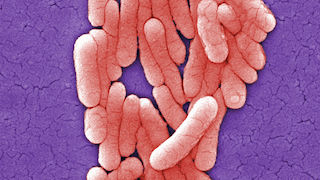How We Could Kill Superbugs Without Antibiotics
Scientists have figured out a new weakness in the defenses of some bacteria.
Antibiotics will soon be useless, but U.K. scientists have come up with a new way to kill bacteria—and it's not with a drug. And perhaps the best thing about this approach is that bacteria may not be able to build resistance against it. A team from the University of East Anglia, publishing in the journal Nature, figured out that the key to destroying bacteria is understanding how they build their defensive walls. It’s like ruining an astronaut’s space suit instead of going after the astronauts inside.
 This would apply against Gram-negative bacteria, a bacterial group that are already highly resistant to antibiotics thanks to an impermeable membrane. "Bacterial multi-drug resistance, also known as antibiotic resistance, is a global health challenge," lead author Changjiang Dong says in a press release. "Many current antibiotics are becoming useless, causing hundreds of thousands of deaths each year. Gram-negative bacteria is one of the most difficult ones to control because it is so resistant to antibiotics."
This would apply against Gram-negative bacteria, a bacterial group that are already highly resistant to antibiotics thanks to an impermeable membrane. "Bacterial multi-drug resistance, also known as antibiotic resistance, is a global health challenge," lead author Changjiang Dong says in a press release. "Many current antibiotics are becoming useless, causing hundreds of thousands of deaths each year. Gram-negative bacteria is one of the most difficult ones to control because it is so resistant to antibiotics."
Dong’s research used the U.K.’s Diamond Light Source synchrotron to examine the bacteria. The DLS is a crazy-bright light source (10 billion times brighter than the sun), and allowed Dong’s team to discover the mechanism by which the bacteria builds its defensive walls. Knowing how the walls are built is the key to destroying them. Drugs could target a structure called the beta-barrel assembly machinery (BAM), which folds the bacteria’s proteins into the defensive membrane...
- Tags:
- antibiotic resistance
- Antibiotics
- Bacterial multi-drug resistance
- beta-barrel assembly machinery (BAM)
- Changjiang Dong
- diabetes
- Diamond Light Source (DLS) synchrotron
- Gram-negative bacteria
- neurodegenerative diseases
- overexposed antibiotics
- Parkinson's
- superbugs
- United Kingdom (UK)
- University of East Anglia (UEA)
- Login to post comments